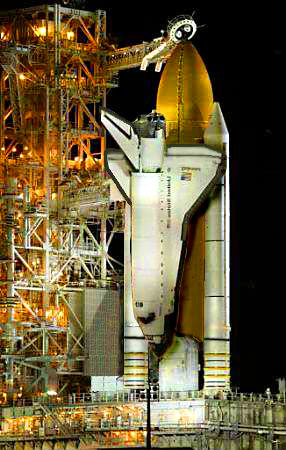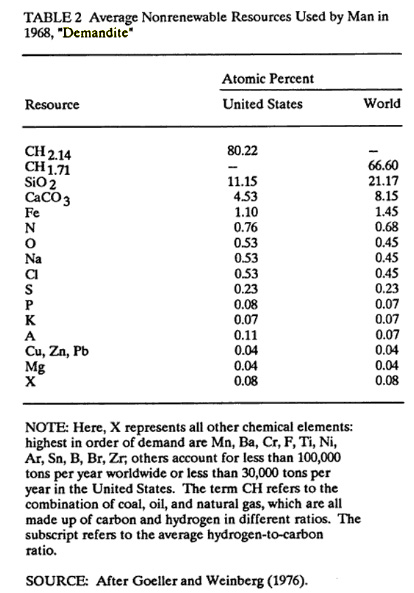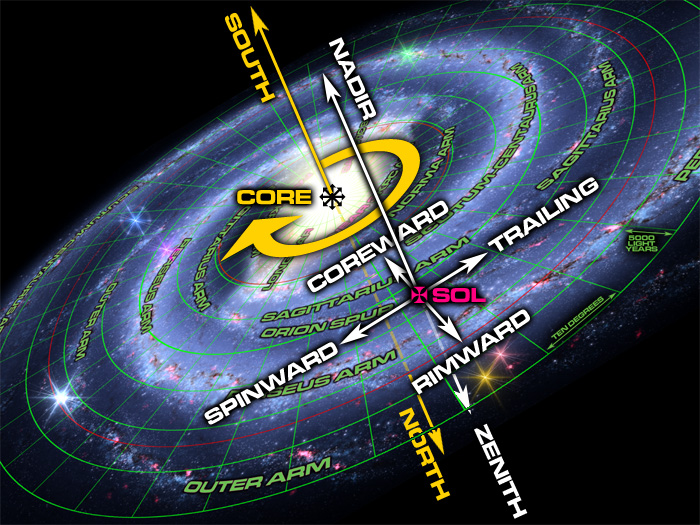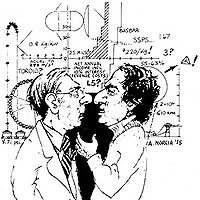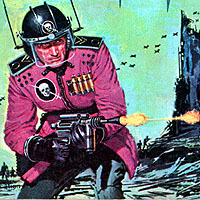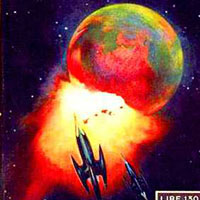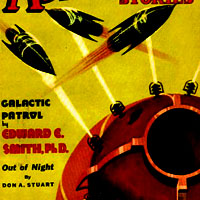What The Heck Is That?
Aliens

The Tholian Web (1968)
Android
A robot constructed out of "living" biological organic materials, as opposed to a robot made out of metal and plastic. Often used as a term for a synthetic human being. First modern use was in Jack Williamson's The Cometeers (1936). It was later popularized by Edmond Hamilton in his Captain Future series, where the android Otho was always bickering with his "brother" the metal robot Grag.
BEM
An alien. In science fiction, particularly bad, campy, or tongue-in-cheek science fiction, a BEM is a "Bug-Eyed Monster," i.e., a stereotypical malevolent creature. (From Wikipedia, the free encyclopedia.)
Berserker
Race of sentient robots whose goal is the destruction of all life. Concept created by Fred Saberhagen for his Berserker series of novels. A possible solution to the Fermi Paradox. In a novel, functionally they are the personification of Death.
Forerunners
Galaxy-spanning alien civilizations that became extinct millions of years ago. Often associated with dead planets destroyed in ancient interstellar wars and with Paleotechnology. Term coined by Andre Norton. Synonyms: Precursors, Ancients, Elder race, Progenitors, Predecessors.
Gasworlder
Alien species that inhabit gas giant type planets. As a rule, species that inhabit terrestrial planets (such as our species) do not have much interaction with gasworlders. In the general this is because we and they have little or no common frames of reference which makes communication difficult. In the specific it is because we and they do not covet each other's real estate so there is no reason to go to war. In Poul Anderson's galactic novels, the human galactic empire and several gasworlder empires interpenetrated each other and ignored each other.
But there are exceptions, such as Kevin J. Anderson's Saga of Seven Suns series. In the first novel, the human empires are unaware of the existence of the Gasworlders ("Hydrogues"). This proves to be unfortunate, when the humans test a device which converts gas giants into blazing suns, this makes the Hydrogues very angry. Hilarity ensues.
Term is from an old Windows 4X computer game Stellar Crusade.

GASWORLDERS
These are intelligent creatures who inhabit the upper layers of Jovian worlds. While none of the gasworlders in the game are technological, they do trade exotic organics for certain manufactued goods.


...the vast majority of sentients (alien races) cannot directly communicate with each other.
Some species operate on different time lines, or are out of phase with the four dimensions we can perceive, are too small or too large, or perhaps, if they had to acknowledge us, they would have to kill us.
So even when an atomic matrix life form that feeds off the microwave hum left over from the Big Bang and excretes time lives in the same solar system with your typical silicon-based life form that eats rocks and excretes hydrogen, communication between them may be close to impossible.
Luckily it's not really a big deal, because they usually don't have anything to talk about. Or so it appears, right up until said atomic matrix life form begins a simple operation to make the local sun go nova in order to harvest neutrinos, and to their surprise, are vigorously opposed by those gritty little creatures clinging to their large orbiting rocks, who have had to start throwing anti-matter around to get their attention, and things usually deteriorate from there.

Paleotechnology
Million-year-old alien high-technology found in the ruins of Forerunner planets. Very valuable and very dangerous. Term is from an old Windows 4X computer game Stellar Crusade.

PALEOTECHNOLOGY
There were several star faring civilizations that preceded us into the galaxy and their artifacts are a tantalizing source of discovery and frustration. Sometimes, these forerunner artifacts can trigger a scientific breakthrough.

Sophont
An intelligent being, of whatever species. Fancy term for "intelligent alien", but also includes humans. From the Greek sophos, "wise" + ont-, "being". Term was coined by Karen Anderson, and popularized by her husband Poul Anderson in his novels. Has also been used by David Brin, Vernor Vinge, Wolf Read, and E. Bes Shahar. Synonyms: Sentient, Sapient.
Elements
Any of these elements can be emphasized with the prefix "Weapons-Grade", meaning "Highly Concentrated".
Avalloy
This element is an economic abstraction. It is an imaginary molecule which is composed of the weight fractions of the major metallic elements consumed by industry of a particular planet or colony. The sum of elemental abundances of metals that must be mined to support civilization, as it were. The amount of avalloy that must be supplied to maintain one person for a year is the "per capita" avalloy requirement.
The non-metallic elements that must be mined to support civilization are called "demandite". Some writer do not use the term "avalloy", instead their demandite includes both metallic and non-metallic resources.
Balonium
An element that is impossible or nonsensical. From the word "baloney" meaning "pretentious nonsense". Sometimes used as a synonym for handwavium.
Bolognium
Synonym for Balonium. Term coined by Larry Niven.
Demandite
This element is an economic abstraction. It is an imaginary molecule which is composed of the weight fractions of the major elements consumed by industry of a particular planet or colony. The sum of elemental abundances of consumables that must be mined to support civilization, as it were. The amount of demandite that must be supplied to maintain one person for a year is the "per capita" demandite requirement.
In space, the concept is how much of each element must be in circulation to maintain one person, since it assumes that all commodities are not expended, but instead recycled in a closed system. Colonies in space cannot afford to waste resources the way we do here on Terra.
The composition varies by location.
On Terra water and air are not considered to be part of the local demandite, since they are assumed to be in unlimited supply. Terran demandite is dominated by fossil fuels.
In space colonies local demandite has large proportions of water and air since they are in short supply. No fossil fuels are included due to abundant solar power.
Some writers split demandite into the metal fraction and the non-renewable resource fraction. The former is called "avalloy" while the latter is called demandite.
Equusfecalium
Humorous term for "horse-sh*t", using Latin.
Handwavium
See main entry.
MacGuffinite
See main entry.
Phlebotinum
Synonym for Handwavium.
Sometimes spelled "flebotinum".
Taurusfecalium
Humorous term for "bull-sh*t", using Latin. Term coined by Dogmatic Pyrrhonist (Tiktaalik Dreaming)
Unobtainium
See main entry.
Galactic Empire
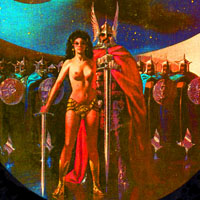
Galactic Empires, vol 1 (1976). Artwork by Karel Thole.
| Groups of Governments | |
|---|---|
| Coalition | |
| Confederation | |
| Federation | |
| Union | |
| Suzerainty | |
| Empire | |
Buffer State
A buffer state is small empire lying between two rival or potentially hostile greater powers, which by its sheer existence is thought to prevent conflict between them.
Coalition
An alliance between governments, during which they cooperate in joint action, each in their own self-interest. This alliance may be temporary, or a matter of convenience. A coalition thus differs from a more formal Confederation.
Confederation
An alliance between governments created by a compact, concord, concordat, covenant, pact or treaty. Confederations tend to be established to deal with critical issues, such as defense, foreign affairs, foreign trade, and a common currency, with the central government being required to provide support for all members. It is similar in structure to a federation but with a weaker central government. The member governments generally retain the right of secession. Synonyms: Alliance, Compact, Concordiat, League, Axis.
Coreward
When giving galactic directions, "coreward" is towards the center of the galaxy. Term was probably coined by Marc Miller for the Traveller RPG.
Occasionally the term "hubward" will be used.
Empire
An Empire is not voluntary, the member regions have been incorporated by force. The leader region is called the "metropole", the subjugated regions are called the "peripheries." The peripheries are ruled by governors, viceroys, or client kings in the name of the Emperor. Synonym: Imperium
Federation
A Federation is similar to a Confederation, but the member governments have surrendered more of their rights and responsibilities to the central government. The member governments (known as states, dominions, or provinces) are still self-governing, but give up control of foreign affairs. Member governments generally lose the right of secession. Synonym: Commonwealth, Assembly.
Fringe
That region of a galactic empire or explored space along its outermost edge. Beyond lies unknown space, space barbarians in their long-ships, and/or other empires and their neutral zones or disputed regions. Synonyms: Rim, Marches, Frontier.
Nadir
When giving galactic directions, "nadir" is in the "downward" direction along the galactic spin axis. "Downward" is "south" as defined by the Right-Hand Rule. Note that real-world galactic maps created by astronomers have got this exactly reversed due to historical reasons.
Neutral Zone
That lens-shaped intersection of two adjacent spherical galactic empires, where their borders overlap. This is the area that will be the first target of an invasion, the trade corridor between the empires, or a demilitarized zone. A neutral zone is typically populated by spies, smugglers, covert battlefleets intent on causing boarder incidents, and planets named "Casablanca".
Rimward
When giving galactic directions, "rimward" is opposite the direction of the center of the galaxy. Term was probably coined by Marc Miller for the Traveller RPG.
Sector Capital
If a portion of a galactic empire is too far from the center of goverment to be effectively governed, it will instead by controlled by a local sector capital. These capitals are controlled by the center of goverment, in theory. When the empire starts to crumble, sector capitals and the area under their control will break off to become small empires.
Sphere of Influence
A metaphorical region of political influences surrounding a government. When a government falls into another's "sphere of influence" that government frequently becomes subsidiary to the more powerful one, operating as a satellite state or de facto colony. Synonyms: Hegemony, Demesne
Spinward
When giving galactic directions, "spinward" is towards the direction of galactic spin. Term was probably coined by Marc Miller for the Traveller RPG.
Occasionally the terms "turnward", "down-spin" or "deosil" are used.
Suzerainty
A Suzerainty is not voluntary, the member governments have been incorporated by force. The member governments are a tributary to the conquering government (the Suzerain), and enjoys some limited domestic self-rule, but no control over foreign affairs.
Trailing
When giving galactic directions, "trailing" is opposite the direction of galactic spin. Synonym: Anti-spinward. Term was probably coined by Marc Miller for the Traveller RPG.
Occasionally the terms "anti-spinward", "up-spin" or "widdershins" are used.
Union
A Union is a Federation where the member governments have surrendered some control of their internal affairs. The main difference between a Union and an Empire is that the Union is voluntary. Synonyms: Amalgamation, Association, Coadunation, Consolidation, Consortium, Polity, Unification.
Zenith
When giving galactic directions, "zenith" is in the "upward" direction along the galactic spin axis. "Upward" is "north" as defined by the Right-Hand Rule. Note that real-world galactic maps created by astronomers have got this exactly reversed due to historical reasons.
Occasionally the term "Acme" is used.
Jargon
Credit
Unit of currency. Science fictional equivalent of a dollar, a Euro, or whatever.
Docsmithian
Adjective meaning the actions/things are being performed or built on a heroically galactic scale, e.g, "Destroying the enemy homeworld by ramming it with a mobile planet is Docsmithinan." The term comes from the inventor and master of space opera, the legendary author E. E. "Doc" Smith. Term was coined by Ken Burnside.
Hand Waving
In a science fiction story "handwaving" occurs when the author is attempting to get past a moment when a difficult explanation is required but without actually giving a plausible explanation (because there isn't any). Usually insubstantial words or impressive but bogus explanations are used in an attempt to convince the audience that the matter has been adequately explained. The handwaving metaphor comes from the body language of politicians and side-show barkers. Go to The Tough Guide to the Known Galaxy and read the entry "HANDWAVIUM".
Handwavium
In science fiction and fantasy stories, handwavium is a substance that may be rubbed on anything to cause an effect needed by a plot. The reader does not know how handwavium would work and the writer hopes nobody cares. In most science fiction the common handwavium is the starship's faster-than-light drive.
Handwavium is some device or principle in an SF story that flat-out violates the laws of physics and thus renders the story not a "hard-science" story
Term comes from "hand-waving" meaning "attempting to get past a moment when a difficult explanation is required". The handwaving metaphor comes from the body language of politicians and side-show barkers. The method is to use insubstantial words or impressive but bogus explanations in an attempt to convince the audience that the matter has been adequately explained.
Synonym: Phlebotinum
MacGuffinite
Tongue-in-cheek term used by SF writers and SF critics. It has its origin in the term "MacGuffin", popularized by Alfred Hitchcock. A MacGuffin is a plot device that motivates the protagonists (and antagonists) often with little or no narrative explanation as to why it is considered so desirable, e.g, the Maltese Falcon. MacGuffinite is some valuable ore, substance, or commodity but with the added difficulty of not introducing unexpected consequences into your SF universe.
An example of a failure to create some MacGuffinite is when an SF author runs afoul of Jon's Law for SF authors. Joe the SF author creates the BaffleGab drive as MacGuffinite, to allow his spacecraft to travel between planets in days instead of months. Jon's Law reveals that the BaffleGab drive ain't MacGuffinite at all: the unintended consequence is that any old tramp freighter spaceship with the BaffleGab drive can vaporize Texas.
SF authors who desire a Rocketpunk future need a MacGuffinite in the form of some incredibly valuable commodity only available in space which must be harvested by a human being that will provide an economic motive for a manned presence in space.
Term was coined by me.
Nifflheim
A synonym for "Hell", generally used as an expletive e.g., "To Nifflheim with that!" . In Norse mythology, Nifflheim is one of the two places where the souls of Norsemen go when they die, the place where the bad Norsemen go (Which they define as those who have died ingloriously of disease or in old age, or dishonorable people who have broken oaths. But I digress). The term is used in the classic novel Space Viking by H. Beam Piper.
Sine qua non
From the Latin, it literally means "without which nothing", and commonly means "the essential, crucial, or indispensable ingredient without which something would be impossible." This phrase was a favorite of E.E."Doc" Smith, and appears in many of his novels.
Technobabble
Tongue-in-cheek term used by SF writers and SF critics. It refers to dialog or explanations in an SF story that are composed of long streams of scientific-sounding nonsense sentences, e.g.,"Reverse the polarity of the neutron flow!"
Unobtainium
Basically this is scientifically accurate handwavium. It refers to some device or principle in an SF story that is allowed by the laws of physics, but it currently beyond our technological capabilities. Insofar as we can postulate that it can be built at all, the laws of physics say it would behave like thus and so. While Handwavium and Technobabble tell you what you CAN do, Unobtainium usually tells you what is NOT possible.
Examples include antimatter weapons, black-hole gravity catapults and Tipler Time Machines. Tipler Time Machine is allowed by the laws of physics. All you need to do is create a huge cylinder of neutronium several light-years long and spin it on its long axis about half the speed of light. Good luck making one, it is weapons-grade unobtainium.
In the movie Avatar they had a room-temperature superconductor called Unobtanium (not unobtainium).
When Wind Blows
Australian slang for nuclear war.
Laws of Science Fiction
Burnside's Advice
Burnside's Advice: Friends Don't Let Friends Use Reactionless Drives In Their Universes.
The trick is making a reactionless drive that doesn't give the characters in your novel the ability to shatter planets with the Naval equivalent of a rowboat (which would throw a big monkey wrench into the author's carefully crafted arrangement of combat spacecraft). Reactionless drives, with no fuel/propellant constraints, will give you Dirt Cheap Planet Crackers. Reactionless drives are postulated because it is so hard to make interesting spacecraft using rockets, but in this case the cure is worse than the disease. Law was created by Ken Burnside.
Burnside's Zeroth Law
Burnside's Zeroth Law of space combat: Science fiction fans relate more to human beings than to silicon chips.
That is, while it might make more logical sense to have an interplanetary battle waged between groups of computer controlled spacecraft, it would be infinitely more boring than a battle between groups of human crewed spacecraft. Law was created by Ken Burnside.
Every Gram Counts
On any rocket-propelled vehicle, every additional gram of mass increases the propellant load horribly. This means the rocket is going to be built out of aluminum and titanium not steel, strutural members are going to be shaved as thin as possible, crew members are going to be encouraged to loose as much weight as possible, and nothing will be carried that you can do without.
Jon's Law
Jon's Law for SF authors: Any interesting space drive is a weapon of mass destruction. It only matters how long you want to wait for maximum damage. "Interesting" is equal to 'whatever keeps the readers from getting bored'. Law was created by Jon Souza.
This is closely related to Niven's Kzinti Lesson. It is a poor trade-off if the spacecraft in your SF universe can travel from Terra to Mars in two days but the exhaust from their lift-off can make the spaceport look like it was hit by a thermonuclear warhead.
Laws of Alien Behavior
These are from the novel The Killing Star.
1. THEIR SURVIVAL WILL BE MORE IMPORTANT THAN OUR SURVIVAL. If an alien species has to choose between them and us, they won't choose us. It is difficult to imagine a contrary case; species don't survive by being self-sacrificing.
2. WIMPS DON'T BECOME TOP DOGS. No species makes it to the top by being passive. The species in charge of any given planet will be highly intelligent, alert, aggressive, and ruthless when necessary.
3. THEY WILL ASSUME THAT THE FIRST TWO LAWS APPLY TO US. Uh, oh... The implication is that the logical behavior for an alien species is to exterminate us as soon as possible.
Laws were created by Charles Pellegrino and George Zebrowski.
Nicoll's Law
Nicoll's Law: It is a truth universally acknowledged that any (online forum) thread that begins by pointing out why stealth in space is impossible will rapidly turn into a thread focusing on schemes whereby stealth in space might be achieved.
Law was created by James Nicoll.
There ain't no stealth in space. But that does not stop people from obsessively trying to find a way around the problem. Before you send me yet another email, please read the link first.
Pineconez' first law
A society capable of building a successful interstellar generation ship will also be capable of building an interstellar relativistic ship simply by virtue of its tech level.
First Corollary:
Building a perfect, failsafe biosphere (as required for a generation ship) is not necessarily simpler than building an antimatter-fuelled torch drive, and (unlike the latter) can't be solved by throwing more power at it. And this is not even discussing cryogenic sleep.
Second Corollary:
It is not necessarily simpler to build a successful, interstellar generation ship than it is to build a successful, interstellar relativistic ship, and the latter is preferable for almost any use case. (The one major advantage of generation ships is probably payload.)
Law was created by Tobias Pfennings.
Pineconez' second law
Assuming a techlevel more advanced than nearfuture (i.e. interstellar -or- extremely cheap interplanetary travel exists), there will exist no true warship which will not ALSO be capable of single-handedly exterminating an entire continent, be it via nukes, kinetics or handwavium bombs.
Corollary:
If you are able to intercept and kill another warship across a star system, you are also capable of reducing to radioactive rubble an entire planetary civilization with little effort.
Law was created by Tobias Pfennings.
Robinson's First Law
Rick Robinson's First Law of Space Combat: An object impacting at 3 km/sec delivers kinetic energy equal to its mass in TNT.
This means a stupid boulder traveling at 2,000 kilometers per second will inflict the damage of 400 kilotons of TNT per ton of rock. Which means each ton of stupid boulder will do twenty times the damage of the Hiroshima bomb. This implies a new unit called the "Rick", which is kilograms of TNT worth of kinetic energy per kilogram of projectile. The "stupid boulder" contains 400 kilo-Ricks worth of damage.
Law was created by Rick Robinson.
Robinson's Second Law
Rick Robinson's Second Law of Space Combat: For every kilogram of handwavium you remove from a setting, you add about 10 cubic meters of impossible to maintain plumbing.
Law was created by Rick Robinson.
Routledge's Law
Routledge's Law: Any interesting battery material for a laser handgun would be more usefully deployed as an explosive warhead.
Laser sidearms are going to require lots of electricity. This means the batteries powering them are going to contain plenty of juice. And as people who have had their laptop computers suddenly burst into flame well know, powerful batteries can be unstable. You may remember that the phaser sidearms in the Star Trek TV shows can be set to explode like hand grenades.
Law was created by John Routledge.
SFnal Lysenkoist Tendency
SFnal Lysenkoist Tendency: when actual, tested science contradicts some detail in an SF story, attack the science.
Generally encountered in the form of some rabid SF fan fanatically attacking the science preventing them from having their warp drive / space fighters / steath in space / whatever. You can read more about it here.
Law was created by James Nicoll.
There Ain't No Stealth In Space
As a general rule, spacecraft cannot hide. They are about as unnoticeable as a steaming pile of dog poop in the middle of a sparkling white linoleum kitchen floor. Read all about it here.
See Nicoll's Law.
3 Generation Rule of Space Colonies
The Three Generation Rule of Space Colonies states that space colonies have an average life-span of three generations until the life-support and other technical system decay to a point where the colony cannot sustain life. As Rick Robinson puts it "the degree of social discipline needed for a space habitat to survive indefinitely is beyond the capability of "normal" human societies. The human tendency to favor short-term expediency. will, over time, make the habitat ecosystem more and more precarious." See the link for more details.
Law was created by Ken Burnside.
Wegener's Law
When a crack-pot is presenting their crack-pot theory, if they compare their theory's reception to the one received by Wegener's Continental Drift theory they would instantly lose the argument. Just because that one mad idea did turn out to be correct, doesn't mean yours is too. Yes, science got that one wrong for a while, but uncounted other mad ideas were proven to be exactly that.
Law was created by Dr. Rhys Taylor.
Military Personnel
Astroguard
A member of a planet's or star system's local military spacecraft force. Term is from SPI's Universe
Espatier
A space marine, a soldier stationed on a spacecraft. Term is discussed here. The best guess I have at how it is pronounced is "Ess pa tee yea"
Freefaller
A soldier in the zero-gravity branch of the federal armed forces. Term is from SPI's Universe
Gropo
Marines. A contraction of "ground-pounder", as opposed to sailor. Term coined by British Navy, popularized by J. Michael Strazynski.
Ranger
A soldier in the standard ground branch of the federal armed forces. Term is from SPI's Universe
Spacy
Astromilitary, that branch of a nation's armed forces which operates in space. Term is analogous to army and navy. Coined in the "Macross" series of anime.
Space Trooper
A soldier in the assault force branch of the federal armed forces. Term is from SPI's Universe
Star Sailor
A member of the federal spacecraft navy. Term is from SPI's Universe
People
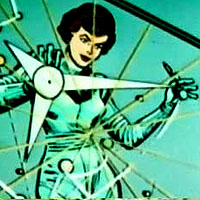
Artwork by Alex Toth for "Space Angel" (1960)
Astrogator
The navigation officer on a spacecraft.
Belter
Person who lives in the asteroid belt.
Corpsicle
A person frozen in cryogenic suspension ("suspended animation"), to be thawed out and revived at a later date. Unlike hibernation, the person is actually clinically dead. Like hibernation, it is useful to reduce a spacecraft's life support requirements for prolonged missions (like century-long slower-than-light interstellar missions) or to stabilize critically ill people until they can be returned to medical facilities. Term was coined by Frederik Pohl and popularized by Larry Niven.
Cyborg
A cybernetic organism. A person with implanted mechanized parts. This can be as mild as a cochlear implant or as major as a giant combat robot controlled by a human brain floating in a tank. Synonym: bionic.
Empath
Person with the psionic power of Empathy.
Esper
Person with psionic abilities, such as telepathy. Term comes from Extra-Sensory Perception. Synonym: Psionic, Psi, Adept, Psychic.
First-in Scout
Space explorer tasked with the job of discovering new planets that are potential colonies or sources of valuable resources, and doing a preliminary survey. An insanely high-risk occupation as one is never sure what sort of hostile alien species, deadly Forerunner artifacts, lethal plagues, anomalous physics, Beserkers, telepathic enslavers, hungry nanotechnology, sentient planets, StarGods, Cthulhoid entities, or other threat may be encountered. Term coined by Andre Norton.
Flatlander
A person who has never traveled into space. Term coined by Larry Niven. Synonym: Groudhog (coined by Robert Heinlein), Ground-Gripper.
Free Trader
Person who lives and works on a starship, traveling to little-known planets to find exotic goods to trade. The crews generally live and own their starship, and experience a hand-to-mouth existence. The opposite is the traders who work for the huge corporations, living as drab little cogs in a drab corporate machine. The corporations have all the choice trade worlds to themselves, while the free traders have to fight over the scraps or do dangerous and financially risky explorations into unknown space. Term was invented by Andre Norton and are featured in her Solar Queen series of novels.
Outsider
In a first-contact situation when humans have never before met an alien species, "outsider" is a term for an alien. Term coined by Larry Niven.
Outworlder
Human from a different planet than whatever the local "here" is. Term is only used for humans, never for aliens.
Pioneers
One who ventures into unknown or unclaimed territory to settle, generally on a new planet. The old bromide is that one can identify a pioneer by all the arrows in their backs.
Rock Rat
Derisive term for "Asteroid Miner"
Spacer
Person who lives or works in space. In Isaac Asimov's novel The Naked Sun the Spacers are the members of the stellar empire who were originally Earth colonists. In other novels by other authors, "spacer" is similar to "sailor", e.g., "You dirty son of a spacer!"
Planet
Burnt-off
An entire planet rendered lifeless by a nuclear war. Term coined by Andre Norton.
Homeworld
That planet where an alien species originated. Earth is our homeworld. Generally in an intestellar civilization, the homeworld is the most populated and the most industrialized. But not always, some homeworlds suffer global thermonuclear war or other disasters.
Terra
The common 1950's era science fictional term for "Planet Earth". Human beings are commonly called "Terrans." A noted exception is in the books of E.E."Doc" Smith and C.S. Lewis who uses the term "Tellus" and "Tellurians" from the Roman term. Go to The Tough Guide to the Known Galaxy and read the entry "TERRA"
Science-fiction Physics
Anti-Agathic Drug
Drug that prolongs human life-span by preventing death due to old age. An immortality drug. Term was invented by James Blish. It is actually incorrect, apparently the Greek word "agathos" ("good") was mistaken for "thanatos" ("death"). And in Philip E. High's novel The Prodigal Sun it is mis-spelled "anti-agastic". Larry Niven had "boosterspice", Cordwainer Smith had the Santaclara drug "Stroon", David Drake has Thalderol.
Ansible
A faster than light communication device created in science fiction by author Ursula K. Le Guin. It is featured in her novels ROCANNON'S WORLD, THE WORD FOR WORLD IS FOREST, THE LEFT HAND OF DARKNESS, and THE DISPOSSESSED. Le Guin states that she derived the name from "answerable" (it was not created as an anagram of the word "lesbian"). The name of the device has since been borrowed by authors such as Orson Scott Card, Vernor Vinge, Elizabeth Moon, L.A. Graf, and Dan Simmons.
Artificial Graviity
Providing the crew members of a spacecraft or space station with something resembling gravity. This is generally done by spinning the habitat module like a centrifuge.
Antigravity
A handwaving way to fly without wings, turning electricity into gravidic repulsion. Please note that the minimum amount of energy required to move from Altitude A to Altitude B is the difference in gravitational potential energy between the two altitudes, plus the energy per second required to overcome gravitational acceleration. Synonym: Antigrav, Agrav, Contragravity, Contragrav.
Autodoc
Medical technology that will accept a person, diagnose their ailments, administer treatments, and if necessary perform surgery.
Bedplate
Antimatter containment unit. Synonym: Seetee Bedplate. A piece of equipment that can hold a quantity of antimatter for prolonged periods, preventing it from touching any matter and causing an annihilation explosion. The term was coined by Jack Williamson for his novels Seetee Ship
Dirac
A faster than light communication device created in science fiction by author James Blish. It is featured in his CITIES IN FLIGHT novels and the novel THE QUINCUNX OF TIME. In the latter novel the Dirac is revealed to have a rather alarming side effect. It is also used in the novel BEYOND CAPELLA by John Rackham. The name comes from physicist Paul Dirac, who predicted the existence of antimatter.
Dyson Sphere
A Dyson-Sphere is a stellar-scale megastructure. Basically it is a shell around a star with a radius of about one Astronomical Unit (a solid shell in science fiction, but in reality it would be a swarm of millions of habitats). The idea is to totally utilize all the energy emitted by a star, instead of wastefully letting it all escape. It would also have a theoretical living surface area about 550 thousand times the surface area of Terra. Which is larger than the number of inhabited planets in your average science fictional galactic empire. Concept was invented by Freeman Dyson.
Faster than light travel
Faster than light travel(aka "FTL") is the major handwavium required by all fast-paced SF novels. It is more or less required if your novel features interstellar trade, warfare, or empires. But all but the most hard-boiled hard-science purist will give you a free pass on that one. You want it, they want it, everybody is doing it. Synonym: FTL, Stardrive, Hyperdrive, Warp Drive, Jump Drive, and a host of others.
Force Field
Science-fictional armor composed not of matter but of some kind of energy. Synonyms: Force screen, Energy screen, Deflector, Force shield, Shield", Screen, and a host of other variations. In some cases the field protects against both material projectiles and directed-energy weapons. Otherwise they only protect against one or the other. Force fields that protect against material projectiles are sometimes called "repulsors" or "repellors". Force fields that protect against directed-energy weapons are sometimes called "ray-screens."
While conventional armor is worthless to protect against nuclear weapons, the science fictional force field is under no such limit. In the name of dramatic tension, force fields often have other limitations.
Fusactor
![]() Contraction of "FUSion power reACTOR". A device that generates electricity using nuclear fusion reactions. Term is only used in science fiction novels.
Contraction of "FUSion power reACTOR". A device that generates electricity using nuclear fusion reactions. Term is only used in science fiction novels.
Matter Transmission
Mechanical teleportation. Popularized in Star Trek under the name "transporter."
In some handwaving explanations of their working principle, the problem arises that if you record the signal it can function as a matter duplicator. Of people as well. In the novel Farthest Star by Frederik Pohl and Jack Williamson the people duplication function is used as a plot point. Even if you can only duplicate inanimate objects there are unintended consequences.
Matter transmitters can just require a transmitter (so you can beam your landing party down to a random location on an unexplored planet) or just require a receiver (so you can beam a few bars of gold bullion out of a bank vault). Or they can require both a transmitter and a receiver.
Larry Niven points out that any planet with two or more nations which develops either a receiverless or transmitterless teleporter will instantly start a war which will only end when they have bombed themselves to a point where their tech base cannot support teleporter technology. You can either materialize nuclear warheads into the enemy leader's lap or you can remove vital components from the guts of their war machines. The only way to avoid this is with teleporters which require both transmitter and receiver or with some hand-waving force field that prevents teleportation.
Teleportation also has problems with the law of conservation of energy and the law of conservation of momentum. If you are in a car travelling at 60 miles per hour, and you teleport out to the sidewalk, you will hit the sidewalk still moving at 60 miles per hour. Not to mention the fact that different latitudes of a planet rotate at different speeds. And if you teleport from orbit to the ground, all that potential energy which comes from altitude has to go somewhere. Probably as waste heat, which will be enough to kill you. Read Larry Niven's The Theory And Practice of Teleportation for details.
There is also the nasty effects of teleporting into a location that is already occupied by another solid object. The resulting explosion is called a "telefrag."
Synonym: Transporter, Transmat, Mattermitter, Matio, Teleporter, Star-Gates.
NAFAL
Acronym for Not As Fast As Light. A slower than light starship. Coined by Ursula Le Guin.
Ornithopter
Aircraft that flies by flapping its wings. Only used in Frank Herbert's DUNE series and in steampunk novels, because it is cinematic but a scientifically silly idea.
Powered Armor
Armored fighting suit with a powered exoskeleton, armed to the teeth. An Iron Man suit. Powered Armor was popularized in Robert Heinlein's Starship Troopers and Joe Haldeman's The Forever War.
Pile
![]() Sometimes "Atomic Pile". Obsolete term for nuclear power reactor. A device that generates electricity by fission reactions. Term is generally only seen in scientific documents and science fiction in the 1940s and 1950s.
Sometimes "Atomic Pile". Obsolete term for nuclear power reactor. A device that generates electricity by fission reactions. Term is generally only seen in scientific documents and science fiction in the 1940s and 1950s.
Term comes from the first nuclear reactor, the Chicago Pile-1, which was basically a huge pile of graphite bricks with uranium-235 rods embedded inside.
Powered Exoskeleton
Exoskeleton with motors at the joints. It reacts to the motions of the wearer and amplifies the wearer's strength. The power loader that Ripley used to beat the living snot out the Alien Queen in the movie Aliens. The main reason such suits have not yet been invented is the difficulty of miniaturizing the power source. The real secret of Iron Man's armor is the tiny Arc Reactor. Synonym: Man Amplifier, Exoframe.
Pseudo-gravity
A handwaving machine that converts electricity into gravitational attraction. Commonly seen on Star Trek and practically every other SF TV and movie featuring starships, built into the deck-plates of the ship and sparing the special-effects budget of the show. This allows them to make all their starships unrealistic Belly-landers instead of scientifically accurate Tail-Sitters as they should be. And they never have a good explanation for why the crew doesn't suddenly start floating around the room when the power cuts out.
Psionics
Mystical powers of the human mind that always seem to be absent when tested for in a research lab, e.g., telepathy. Person with such powers is an "Esper". Psionics was popularised by John W. Campbell jr., E. E. "Doc" Smith ("Lensmen"), A. E. van Vogt ("Slan"), Robert Heinlein ("Time for the Stars"), Larry Niven, James H. Schmitz, and Andre Norton. Not to mention the telepathic Vulcans of Star Trek, the Jedi Knights from the Star Wars movies, and the nasty Psi Corps of Babylon 5.
In space opera a person seldom has all the psionic abilities, they generally only have two or three. The use of a psi power has three components: power level (measured in "psychic energy"), information content, and target vector. Some have limitations for dramatic reasons: your evil overlord's ability to use apportation to make your protagonist's still-beating heart teleport in the overlord's hand is just a little too overwhelming. Telepathic receiving was popular in early space operas, when the authors didn't want their characters wasting dramatic tension in taking months learning an alien language.
Sometimes psionic powers can be aided or hindered by technological devices. In Doc Smith's Lensman series, bad guys could wear "thought screens" to prevent their thoughts from being read (at least as long as the battery lasts). In Poul Anderson's Flandry novels, Flandry also uses a thought screen to deal with the dangerous telepathic agent Ayrcharaych. In the Traveller RPG they have "Psionic Shield Helmets." In A. Bertram Chandler's Commodore Grimes series, interstellar communication is performed by telepaths whose powers are amplified by a device which includes a living dog brain in a tank. In Alexis A. Gilliland's The End of the Empire tractor beams are human psychokinesis experts who require a laser beam as a sort of crutch.
In science fiction there are often organizations that help psionic individual reach their full potential. Such organizations can be legal or underground. In Babylon 5 there is the Psi Corps with Psi Cops who hunt rogue telepaths (but the Psi Corps has covertly taken control of key politicians). In Babylon 5, telepaths must either join the Psi Corps and submit to their discipline, or be given a weekly dose of a drug that suppresses their telepathic power (non-telepathic humans can be so fearful at times). In the Traveller RPG there is the Psionics Institute, a public organization dedicated to research and training in the psionic sciences. In Richard McEnroe's The Shattered Stars there is also a Psionics Institute, but undercover since in that universe Psionics is illegal, and Psis are to be captured and imprisoned.
In Hal Clement's short story "Impediment", he points out that using telepathy as a translator for alien language is nonsense. He says that each person has a mental language for their thoughts. In a society of telepaths, infants telepathically learn the common mental language of their species. But in a society of non-telepaths, everybody grows up creating their own unique mental language. So a poor telepath has to learn an entire unique mental language just to telepathically talk with one non-telepath. And the telepath has to repeat that for every new non-telepath they want to communicate with.
In Limiting Factor by Theodore R. Cogswell, a secret group of Espers have been working for years to master their powers. They figure they are the next stage in human evolution. They eventually contact aliens who seem to also have well developed psionic powers. But no, the aliens do not. Instead they have miniaturized technology. The aliens point out to the silly Espers that while it is cute to use psionics, flesh is weak while technology is not. Sure one can walk from place to place. But to go faster, instead of trying to breed people with bigger legs, does it not make more sense to invent an automobile? The same is true of psionics.
- Absorption: anti-psi power that sucks the energy out of another's use of psi power (affects power level) and gives the raw energy to the user. Acts much like the Langston field. Can also be used to suck "life-force" out of another person (pychic vampire).
- Amplification: ability to add energy to another esper's psi power.
- Anti-psi: a catagory of psionic abilties that can be used as a defense against standard psionic abiliites. Can affect any or all of power level, information content, and vector to target.
- Apopsi: anti-psi power that makes a force field (mostly) impenetrable to another's psi power.
- Aportation: the ability to make an inanimate object vanish from point A and appear at point B without traveling through the space in between.
- Astral Projection: the ability to leave ones body, traveling in an immaterial ghostlike body while ones physical body is in a trance.
- Bonding control: the ability to affect the molecular bonds in inanimate objects. Uri Gellar claimed to have this power but all he could do was bend spoons.
- Catapsi: anti-psi power that generate psychic "static." It affects the information content of another's psi power.
- Cellular control: the ability to affect living cells for healing or for harm with one's mind.
- Clairaudience: extra-sensory perception where the information received appears in the user's sense of hearing.
- Clairgustance: extra-sensory perception where the information received appears in the user's sense of taste.
- Clairolfaction: extra-sensory perception where the information received appears in the user's sense of smell.
- Clairtangency: extra-sensory perception where the information received appears in the user's sense of touch.
- Clairvoyance: extra-sensory perception where the information received appears in the user's sense of sight.
- Damping: anti-psi power that drains the energy out of another's use of psi power. Unlike Absorbtion, you don't get the drained energy, it is just lost.
- Deflection: anti-psi power that affects the target vector of another's use of psi power. It makes them miss the target, but may strike an innocent bystander.
- Density control: the ability to affect an object's density with your mind.
- Electric control: the ability to affect electricity and plasmas with one's mind.
- Empathy: telepathic receiving, but can only read another person's feelings, not thoughts.
- Gravity control: the ability to affect the intensity of the local gravity field with one's mind.
- Klutzokinesis: the ability to make another person unusually clumsy with one's mind.
- Levitation: the ability to make an object float with one's mind.
- Light control: the ability to affect light with one's mind. Can be used to create visual illusions. Synonym: Psycholuminescence
- Magnetic control: the ability to affect magnetic fields with one's mind.
- Mass control: the ability to affect an object's mass with one's mind.
- Mesmerism: to hypnotize a person using telepathic suggestion instead of verbal suggestion.
- Mental projection: astral projection but without a ghostly body, just a disembodied point of perception.
- Negapsi: anti-psi power that alters the information content of another's use of psi power.
- Precognition: the ability to forsee future events with one's mind.
- Psychkinesis: the ability to move objects with one's mind. Synonym: telekinesis.
- Psychometry: the ability to hold an object and see its past history.
- Radiation control: the ability to affect the decay rates of radioactive elements with one's mind.
- Reddopsi: anti-psi power that alters the target vector of another's use of psi power. It sends the psi power right back where it came from.
- Retrocognition: the ability to see historical events with one's mind.
- Telepathic receiving: the ability to read another person's thoughts. Note that this is a different ability from telepathic sending.
- Telepathic sending: the ability make another person hear your voice inside their head, or implanting thoughts and ideas.
- Teleportation: the ability to move yourself from point A to point B without traveling through the space in between.
- Temperature Control: the ability to raise or lower an object's temperature with your mind. Synonym: psychopyresis.
- Transmutation: the ability to change the elemental structure of an object with your mind
Pressor Beam
Science-fictional beam of some kind of energy that causes an object move further away from the beam projector. Coined by E.E."Doc" Smith. Synonyms: Repulsor, Repeller beam. By Newton's Laws, both the projector and the target object will be moving. Their motion will be proportional to their relative masses.
Reactionless Drive
Science-fictional propulsion system for spacecraft that does not rely upon expending reaction mass. SF authors like it because is it very difficult to make interesting spacecraft while using rocket propulsion. Unfortunately, not only does it violate the law of conservation of momentum, it has a nasty unintended consequence. See Burnside's Advice.
Regeneration Tank
Medical technology that allows a severely wounded person to re-grow any damanged bits. Frank Herbert called them "Axolotl tanks", after a species of salamander that can grow back lost limbs.
Seetee
Slang for "Antimatter". It derives from "C.T" or "Contra-terrene." The term was coined by Jack Williamson for his novels Seetee Ship and Seetee Shock.
Tractor Beam
Science-fictional beam of some kind of energy that causes an object to approach the beam projector (as if it were a magnet). Originally "Attractor beam", coined by E.E."Doc" Smith. By Newton's Laws, both the projector and the target object will be moving. Their motion will be proportional to their relative masses.
Spacecraft
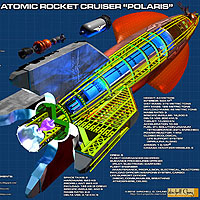
Artwork by Me
Acceleration Couch
Sort of a high-tech waterbed that allows a crew member to survive prolonged periods of multi-g acceleration. Synonym: Cider Press, Gee Bath.
Aerobraking
Aerobraking is to slow down a spacecraft by diving through a planet's atmosphere and letting air friction do the job. This can be done to take a spacecraft out of an interplanetary trajectory and into an orbit around a planet. It can also be done to move to a lower orbit, or as a prelude to landing on the planet.
The advantage of aerobraking over using a spacecraft's engines is that you do not have to burn propellant. NASA and other space exploration agencies use aerobraking because their pathetically weak chemical rockets are not powerful enough to carry enough propellant to do a powered slow-down. A science-fictional rocket might be force to use aerobraking because they do not have enough propellant in their tanks (due to hostile weapons fire perforating the tanks, sabotage, piracy, or other unusual reasons).
Aerobraking is the reason why the planet Mercury is the most propellant-expensive terrestrial planet in the solar system to land on. The other airless planets have much lower gravity so do not need as much propellant. The higher-gravity planets all have atmospheres so one can use aerobraking instead of expending propellant.
Auger In
To crash ones spacecraft into the ground, creating a crater with a few pathetic burning spacecraft fragments lining the bottom. This is an old aviation expression, "Did ya hear about Ed? The poor guy augered in..." The expression comes from "auger", a drilling device used to make holes.
Belly-lander
A spacecraft that when landed has both its tail and nose pointed horizontally like a landed Space Shuttle i.e., the decks are parallel to the thrust axis. The layout is similar to a commercial passenger airliner. More or less the opposite of "tail-sitter"
Booping
Docking two spacecraft nose-to-nose. Only needed if one or both of the spacecraft have nuclear powered rocket engines barely protected by shadow shields. Term coined by Alistair Young, a re-use of the word for "tapping your pet affectionately on the nose."
Drive
Spacecraft propulsion system, e.g., "Ion drive", "Warp drive."
Flitter
Small aircraft often carried by planetary exploration spacecraft. They commonly can hover, and ususally use antigravity or something more interesting than helicopter blades. Term popularized by Andre Norton.
Generation ship
Type of slower-than-light starship that deals with century-long trip times by having the crew raise their children as replacements. Popularized by Robert Heinlein in Orphans of the Sky.
Lithobraking
![]() To slow down a spacecraft by impacting a planet. Occasionally this is done on purpose, but usually "lithobraking" is an euphemism for "crashing." The term is a whimsical variant on the word "aerobraking."
To slow down a spacecraft by impacting a planet. Occasionally this is done on purpose, but usually "lithobraking" is an euphemism for "crashing." The term is a whimsical variant on the word "aerobraking."
Rob Davidoff calls crashing: "lithobraking into a low-altitude synchronous orbit."
Seed ship
Type of slower-than-light starship that deals with the problem of accelerating massive ships by reducing habitat module to a bank of fertilized ova, set of artificial wombs, and computer-controlled robot mommys.
Skimmer
Small ground car often carried by planetary exploration spacecraft. Science fictional groud effect vehicles (hovercraft), but usually using antigravity.
Sleeper ship
Type of slower-than-light starship that deals with century-long trip times by freezing the crew into suspended animation.
Tail-sitter
A spacecraft that when landed has its tail on the ground and its nose pointed skyward like a Saturn V rocket i.e., the decks are perpendicular to the thrust axis. The layout is similar to that of a sky-scraper. More or less the opposite of "belly-lander." Realistic interplanetary spacecraft tend to be tail-sitters.
Torchship
Spacecraft with an absurdly powerful propulsion system, one capable of Brachistochrone trajectories. Details here. The term "Torchship" was coined by Robert Heinlein, and is featured in his stories Farmer in the Sky, Time for the Stars, Double Star, and "Sky Lift". Sometimes it is referred to as "Ortega's Torch". Nowadays it is implied that a Torchship is some kind of high thrust fusion drive, but Heinlein meant it to mean a total-conversion mass-into-energy drive.
Spacecraft, Combat
| Independent patrol | Main battle fleet | |
|---|---|---|
| Small sized ships | Frigate | Destroyer |
| Medium sized ships | Cruiser | Armored Cruiser |
| Capital ships | Battlecruiser | Battleship |
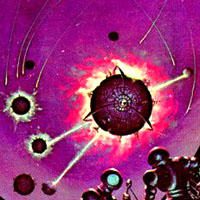
Artwork by Jack Gaughan for "First Lensman" (1950)
Armored Crusier
A Medium combat spacecraft used in the Main battle fleet. It trades endurance for enough armor to maybe survive a hit from a capital ship's weapons without being mission killed, and usually has the same number of weapons as the independent patrol cruiser but with each weapon packing more of a punch.
Auxiliary Units
Type of combat spacecraft that are more for logistics than for fighting. Fuel (and reaction mass) ships, supply (logistical) ships, transports, repair ships, hospital ships, missile supply ships (colliers), ammo ships, mine-sweepers, fighter tenders, destroyer tenders. An army fights on its stomach, a fleet fights on its reaction mass. Auxiliary units can operate as either Independent Patrol or Main battle fleet.
Battlecruiser
A Large (Capital) combat spacecraft used for Independent patrol. Has massive amounts of weapons and the defenses to stand up to hostile fire from enemy battlecruisers. Has increased endurance and reduced weapons as compared to a battleship. But the endurance is still secondary to the weapons. Some battlecruisers have reduced defenses and increased speed compared to the corresponding battleship, so it can outrun anything it cannot outgun.
Battleship
A Large (Capital) combat spacecraft used in the Main battle fleet. Has massive amounts of weapons and the defenses to stand up to hostile fire from enemy battleships. Has increased weapons and reduced endurance as compared to a battlecruiser. The largest battleships are sometimes called Dreadnought.
Cruiser
A Medium combat spacecraft used for Independent patrol (exception: see Light Cruiser below). Unlike destroyers and battleships, cruisers are designed to be balanced with respect to speed, defenses, and weapons. The cruiser is a frigate that's generally got more weapons, more defenses, and more survivability. It usually has greater endurance. Generally a cruiser can outrun anything it cannot outfight. Used for convoy raiding, deep scouting, and related missions. Heavy cruisers have large endurance for long distance scouting. Medium cruisers are often used as raiders, on convoys and other soft targets. Light cruisers are actually Main battle fleet units, scouting and repelling attack by enemy light cruisers and destroyers.
Combat Spacecraft
A spacecraft with guns. Generally they are always manned by people instead of computers due to Burnside's Zeroth Law of space combat: Science fiction fans relate more to human beings than to silicon chips. The five major dimensions of combat spacecraft design are defenses, weapons, speed/maneuverabilty, endurance (how long between refueling and re provisioning), and command & control (how large the bridge crew is, which boils down to how many different tasks can be done simultaneously). The difference between various designs is what dimension have been increased at the expense of what other dimensions e.g., a destroyer has increased speed at the expense of reduced defenses. More details here.
Control Ship
Also called a "Space Control Ship". A lightly-armed combat spacecraft carrying an enormous C4I electronics suite (communications/command/control/computers/intelligence) tasked with controlling huge numbers of remote-controlled space combat drones. Sort of like the brain center inside a huge swarm of deadly space-going hornets.
Please note that the control ship probably will NOT carry and service the drones, since the control ship will have to be nimble enough beat a hasty retreat if the battle goes terribly wrong. The drones will be carried by separate parasite-carrier spacecraft. The control ship might contain the only live human beings in the entire swarm.
Destroyer
A Small combat spacecraft used in the Main battle fleet. Traditionally they protect friendly battleships from enemy torpedo boats while the friendly battleships protect them from enemy battleships ("destroyer" is short for "torpedo-boat destroyer"). Destroyers and battleships support each other. Typically their design reduces the armor and other protection in order to increase their speed and maneuverability. They also have guns optimized to kill torpedo boats: quick-aiming but at the cost of not having enough power to damage anything much larger than a torpedo boat. Destroyers also hunt enemy submarines. A destroyer-escort is a destroyer with less speed and more endurance than a standard destroyer, designed to travel with friendly convoys and protect them from enemy submarines and fighters.
Dreadnought
The largest size of combat spacecraft. A large battleship. E.E. "Doc" Smith spelled it "Dreadnaught."
Firing Solution
The settings for aiming your weapons that will (hopefully) allow the weapons fire to strike the target. A fire-control system uses information from the targeting sensors in order to compute the firing solution. The target will generally be dodging around in an attempt to complicate the firing solution, prolonging the time to calculate the solution and/or making the solution incorrect.
Fleet
Group of combat spacecraft. This is more of an organizational fiction rather than an actual entity. What one generally encounters in the field is a Task Force, not a fleet.
Frigate
A Small combat spacecraft used for Independent patrol. The smallest spacecraft that can be armed with weapons capable of bombarding enemy planets and orbital fortresses.
Independant Patrol Units
Type of combat spacecraft that operate alone as a task force of one. Independent patrol sacrifices firepower (and sometimes protection) for cruise endurance and multi-mission capabilities. Opposite of Main battle fleet units.
Kinetistar
A combat spacecraft or weapons platform with a hypervelocity kinetic energy weapon built into a
Kirklin Mine
Kirklin mines are a defense against torch missiles. It is such a good defense it could render torch missiles to be totally worthless. They are basically huge numbers of dime-a-dozen chemical-rocket-powered kinetic-energy-weapons.
Lancer
A Lancer is a small fighter-type combat spacecraft armed with kinetic energy weapons and/or missiles where most of the weapon kinetic energy is supplied by the spacecraft's engines. Example: imagine a fighter accelerating to 3 kilometers per second on collison course with a Blortch Empire space battlecruiser, lightly ejecting a few penetrator shells, then frantically trying to change its vector so it doesn't crash into the battlecruiser. The inert penetrator shells will tear through the battlecruiser at 3 km/s relative doing damage as if they were packed to the gills with TNT.
Generally this is a preposterous waste of your combat dollar, unless there are special circumstances. Right off the bat the Lancer spacecraft will need at least four times the delta-V of an equivalent missile, since unlike the missile the Lancer is not on a suicide mission. A missile just has to do one burn to the target. The lancer has to burn for the target, do a counter-burn to stop, do a burn for home, and do a counter-burn to stop at home.
Laserstar
According to Rick Robinson, a "laserstar" is a combat spacecraft built around a huge laser weapon where the beam can be directed by mirrors into multiple turrets. Laserstars tend to be power-hogs, requiring huge amounts of electricity.
Occasionally the term is used for an impressively armed combat spacecraft suitable for political use in gunboat diplomacy.
Logistics
The art and science of keeping one's military units supplied with ammunition, food, and other necessary items. The old bromide is that amateurs talk about battle tactics while professionals talk about logistics. The sad fact of the matter is that logistics is about ten times more difficult than tactics, but a lot less glamorous.
Main Battle Fleet Units
Type of combat spacecraft that operate as a team with other units in their task forces, generally to fight battles. Main battle fleet requires ships to be 'honed to the bone' — anything that doesn't make the ship more capabile in a fight is usualy a luxury. Main battle fleet units sacrifice cruise endurance for firepower (and sometimes protection). Opposite of Independant patrol units.
Mission Kill
When a combat unit is not actually totally destroyed by hostile weapons fire, but has sustained enough damage that it can no longer participate in the assigned mission.
SCOD
Submunitions. These are multiple anti-ship weapons carried in a single missile bus, such as a multiple independently targetable reentry vehicle (MIRV). In that example, the ten or so nuclear warheads carried in a single MIRV are the SCODs.
Name is an acronym of "Soda Cans of Death", which is the general size and shape of kinetic energy submuntions.
Spaceguard
In the military world, the spaceguard is that branch of the astromilitary charged with preventing unauthorized changes in asteroid orbits. A small asteroid dropped on to Terra could devastate an entire nation. A large asteroid could destroy all civilization on Terra. There are more details here.
Orbital Fortress
A fort in space. A space station brisling with weapons and armored in defenses, orbiting whatever they are tasked with protecting. Since they are not expected to move under their own power, the mass that would have been devoted to propulsion is instead used on weapons and defense. Thus an orbital fortress is far more deadly and harder to kill than a combat spacecraft of the same mass.
Point Defense
Small weapons mounted on combat spacecraft in order to attack hostile incoming missiles and fighters. A missile defense system.
Scanner
An active sensor, that is, a sensor that emits something and detects the echo. Radar or Lidar. Active sensors give more information about the target than passive sensors, but also draw attention to yourself.
Sensor
A passive sensor, that is, a sensor that just looks around for emissions from the target, but emitting nothing. Passive sensors give less information about the target than active sensors, but do not draw attention to yourself.
Signature
A distinctive pattern detected by sensors which identifies what you are looking at. For instance, a burst of x-rays followed some time later by neutrons is the signature of a nuclear warhead detonation.
Speed/Maneuverabilty
In space, speed and maneuverability do not mean the same thing that they do for a Earthbound automobile or wet-navy vessel. This is because there is no friction in space. Instead, there is Delta-V and Acceleration.
Delta-V is the spacecraft's total possible change in velocity, i.e., the final speed if the ship pointed its nose in a certain direction and burned its propellant until the tanks ran dry. Varioius missions (e.g., lift-off from Terra, Hohmann trajectory to Mars, landing on Mars) have a delta-V requirement. If the ship has enough delta-V capability, it can perform that mission. Delta-V depends upon the specific impulse (fuel efficiency) of the engines and the size of the propellant tank.
Acceleration is how fast the ship can change its velocity, this corresponds to maneuverabilty. If the acceleration is low, the ship is "lumbering." If it is high, the ship is "agile." This is important for Evasive Maneuvers, dodging around rapidly enough to make it harder for the enemy to shoot you (aka "Complicating the firing solution"). Acceleration depends on the thrust capacity of the engines and the mass of the ship.
Submarine
There ain't no stealth in space, at least not in scientifically accurate science fiction. However, if your SF universe contains some sort of handwavium stealth (aka a "cloaking device"), ships equipped with it will operate much like submarines during World War II. In the classic Star Trek episode Balance of Terror the Starship Enterprise fights a Romulan Warbird equipped with a cloaking device. The writer Paul Schneider drew upon the WWII submarine film The Enemy Below for inspiration, with admirable results. The advantage of submarines is that they are very good at hiding, and can attack while hid. They are the bane of enemy convoys, and submarine minelayers are quite a headache for the enemy. Submarines are hunted by convoy escort ships and "sub-chaser" ships. Due to the trade-off of mounting a cloaking device, submarines tend to have short endurance and thus require strategically-placed friendly bases or submarine-tender ships.
Task Force
A small group of combat spacecraft that has been "detached" from a fleet and charged with performing a specific mission. When the mission is completed, the ships of the task force are dissolved back into the fleet.
Time On Target
A combat starship is sometimes armed with a variety of weapon types whose destructive effects travel at different speeds (e.g., missiles and laser beams). Firing the weapons "time-on-target" means delaying firing the speedier weapons such that all the weapons fire from all the weapon types strike the hapless target simultaneously. Also used if several friendly combat spacecraft are at different distances from one target.
Torch Missile
Conventional missiles come equipped with propulsion that is high acceleration but short duration (e.g., a few seconds). They sprint to their target, but do not have the endurance for a prolonged chase.
Torch missiles, on the other hand, are equipped with propulsion giving them acceleration and delta-V comparable to the target spacecraft they are trying to kill. Which means if you do not kill the missile first, it will chase you all over entire the solar system. For years. And it will eventually catch you because it is on a suicide mission and you are not.
The drawback is such a missile will be almosts as expensive as their prey. And it has no special immunity from the target's point-defense.
If your point-defense is ineffectual against an enemy torch missile chasing you, the expensive solution is to target it with a friendly torch missile of your own. As with most things, allowing your warships to carry large numbers of torch missiles has unintended consequences.
The dirt-cheap solution is to kill the enemy torch missile with hordes of inexpensive Kirklin Mines. Since a spacecraft can carry a gazillion Kirklins for the price of one torch missile, this strategy could very well make torch missiles an utter waste of good military expenditure.
Torpedo boat
Type of combat spacecraft designed with high speed and agility, and a weapon capable of doing serious damage to a battleship. The cost is that the design has zero defenses except maneuvering, and the weapon only has a few rounds of ammo. Very similar, if not identical, to a fighter spacecraft. They typically operate in packs to kill enemy battleships, and are hunted by enemy destroyers.
Weapon
Blaster
A type of directed-energy weapon that shoots holes in the target. Often "blaster pistol", "blaster rifle", and "blaster cannon." Term was coined by Nictzin Dyalhis in When the Green Star Waned (1898). In reality this would be a pulse-beam laser. See Heat Ray
Bolt-gun
Directed-energy weapon that shoots electricity. Synonym: Fulgurator.
Bomb-pumped laser
Lasers have to be "pumped" with the same frequency that they emit. So an x-ray laser has to be pumped with x-rays. Alas the only good source of x-rays is a fission warhead. A bomb-pumped laser pumps the laser wtih a fission warhead, and hopes the laser gets off one good bolt before the laser is vaporized by the bomb blast.
Casaba-Howitzer
A nuclear shaped-charge. When the warhead detonates, it skewer the hapless target with a spear of nuclear flame.
Cobalt bomb
A nuclear bomb designed to produce more than the usual amount of deadly radioactive fallout, i.e., an enhanced-fallout weapon. The technical term is "salted bomb." The weapon is basically a conventional nuclear device encased in a jacket of cobalt or or zinc. Cobalt bombs are not used for spacecraft to spacecraft combat, it is only used for planetary bombardment.
Combat mirror
System where instead of each combat spacecraft carrying their own laser, one huge powerful laser is mounted on an orbital fortress or moon base and each spacecraft (or satellite) carries a large parabolic mirror. The spacecraft angles the mirror so that the laser beam from the fortress does a bank shot off it and is focused into a lethal pin-point on the target. The advantage is that the fortress can mount a much bigger laser than a spacecraft, and the spacecraft is more agile since a mirror has much less mass than a laser. But there are disadvantages with distance from the fort, the big laser having to multi-task with all the spacecraft, and the all-your-eggs-in-one-basket problem.
Death Ray
A handwaving directed energy weapon that somehow just kills people while not damaging inanimate objects. Sort of like a beamed neutron bomb.
Directed-energy weapon
A laser or particle beam weapon.
Disruptor
Weapon that causes the target to fall into fragments or vaporize by disrupting molecular bonds. Popularizied in Star Trek as the hand weapons used by Klingons. Synonym: Disintegrator, Disintegrator Ray.
D.R. blaster
In the movie Forbidden Planet, Dr. Morbius asks Captain Adams "May I borrow that formidable looking sidearm?" "D.R." probably stands for "Disintegrator Ray".
EMP Weapon
Bomb designed to create strong electro-magnetic pulse designed to fry electronics and electrical equipment.
Fulgurator
Directed-energy weapon that shoots electricity. Synonym: Bolt-gun.
Gyrojet
A handgun firing rocket propelled bullets. It was made during the 1960s, then discontinued. In the original 1928 Buck Rogers comic strip, the American freedom fighters are armed with rocket pistols, while the sinister Mongol Hordes have deadly disintegrator rays.
Heat Ray
A type of directed-energy weapon that softens, melts, burns, or vaporizes the target. In reality this would be a continuous-beam laser. See Blaster. Term was probably invented by H. G. Wells.
MilSpec
An item that has been manufactured so that it conforms to all the military specifications for that item. MilSpec criteria include every aspect of the item, from the materials it is made from to the treatment of those materials, the dimensions of components made from those materials, testing of these parts, wear and durability, accuracy, service life — every excruciating detail is specified. Finally the item must be approved by military inspector.
Needler
A weapon which punches long but narrow holes in the target either by deadly threadlike beams or with needle bullets. Generally a sidearm, rarely a huge ship mounted weapon (except in E.E. "Doc" Smith's LENSMAN series)
Neutron bomb
A nuclear weapon that has been optimized to produce less blast but more radiation (technically produce less x-rays and more neutrons). The idea is to just kill the enemy soldiers but not render worthless the territory or any useful buildings and whatnot.
The trouble the dosage. Unless you can guarantee that the enemy soldiers receive 20 grays or more of radiation, you have just made things worse. At lower doses, what you have done is made the enemy soldier very angry at you, and aware that they have only a week to live and thus will be more than happy to run a suicide misson on you.
Plasma weapon
Ray-gun
A directed-energy weapons, i.e., a laser or particle beam weapon.
Rattler
Weapon that pairs a tractor beam with a pressor beam. It pushes then pulls the target with an acceleration of one hundred gs with the polarity changing several times a minute.
Self-forging warhead
A shaped charge used to explosively deform a metal plate into a spear and accelerate it into the target.
Shaped charge
An explosive whose geometry make most of the explosive force travel in one direction instead of every which way. It forms a white-hot jet of flame.
Slug-thrower
A conventional firearm that shoots bullets.
Solar Phoenix bomb
Bomb with a nuclear fusion warhead.
Stunner
A less-lethal sidearm that renders the target unconsious. Synonym: Stun-gun. They are less-lethal instead of non-lethal because currently there isn't any such thing as a non-lethal weapon.
Weaponize
To adapt an item in such a way that it can be used as a weapon. A virus that has been genetically engineered so it is fatal and highly contageous has been weaponized. Plutonium that has been powdered and loaded into a spray cannister has been weaponized. An infectious combat meme is a weaponized Lolcat.
Weapons Grade
A potentially dangerous substance that has been refined to the point where that potential is fully realised.
